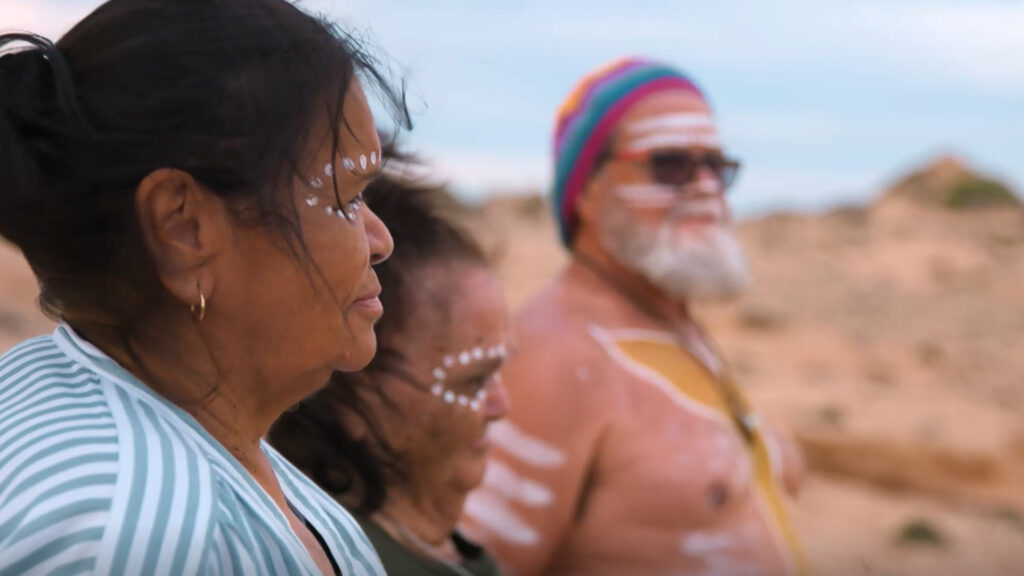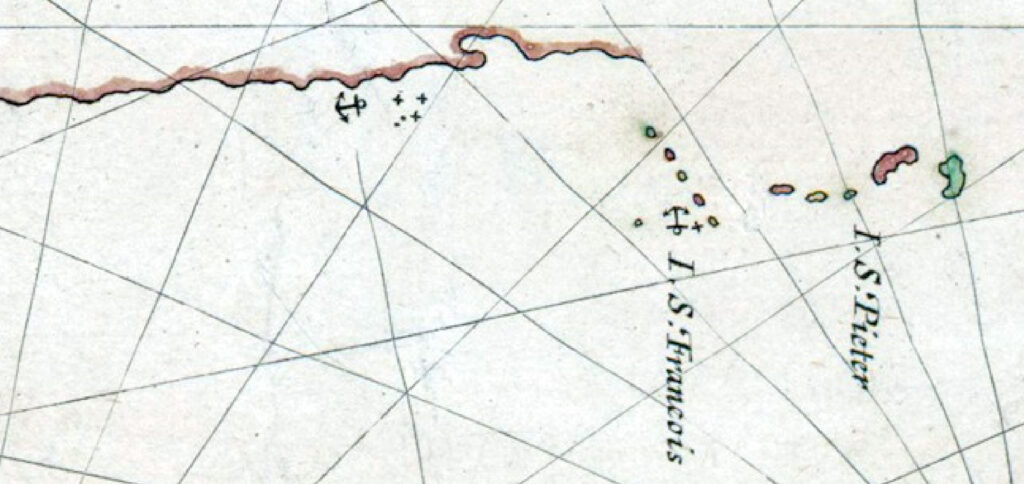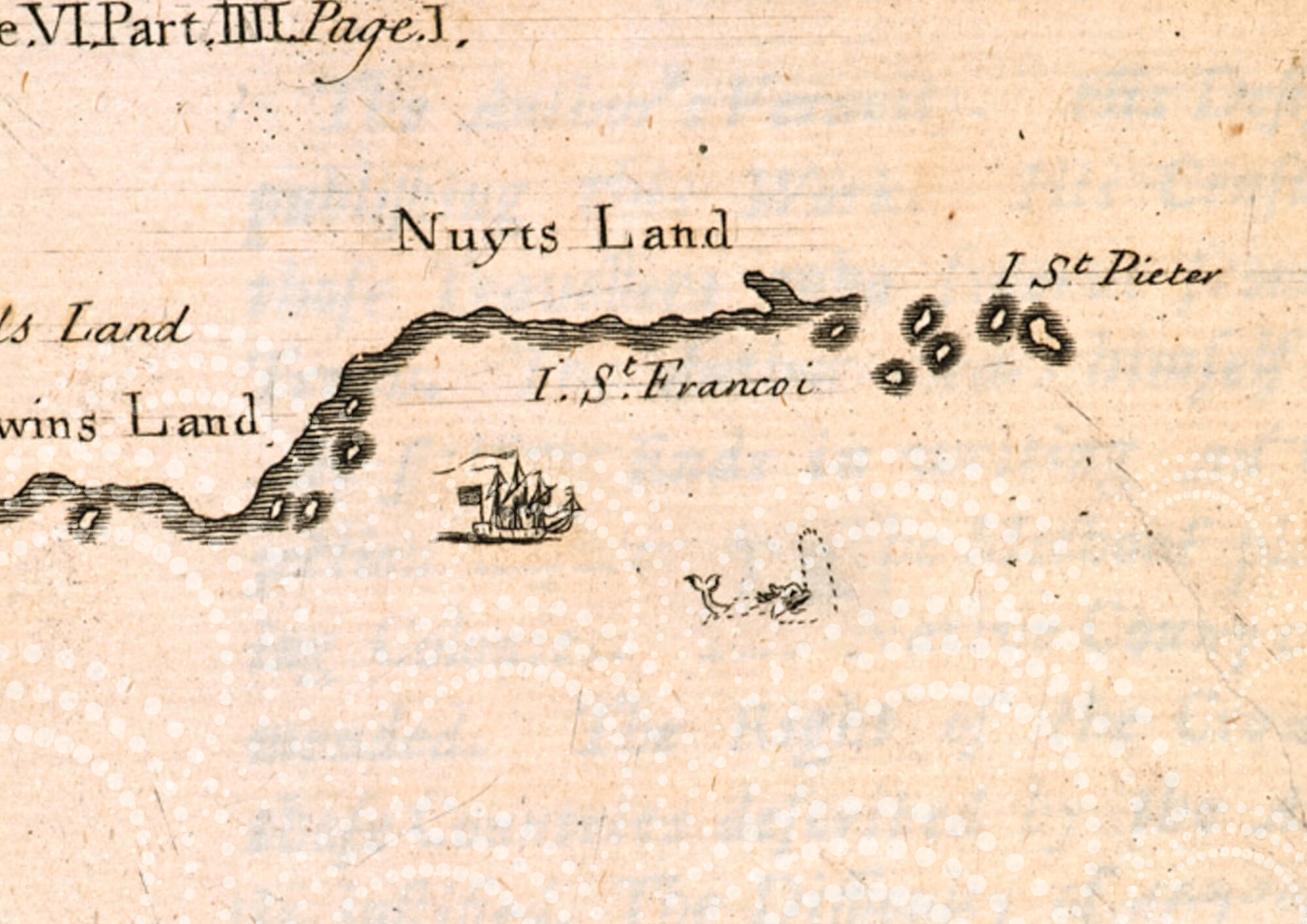For generations, there have been stories passed down about a meeting with people who were as white as ghosts, arriving from the sea. This was before the sealers and whalers and was understood as a friendly meeting.
Members of our Mirning Community were interested to hear of the Dutch stories of an early European encounter with our ancestors that occurred nearly 400 years ago. This led to working with a grant from the Embassy of the Kingdom of the Netherlands (Australia) and in partnership with Australian Catholic University historians and the National Archive of the Netherlands. What transpired is that the Dutch ship records were lost, and it is our oral histories of meeting the crew of ‘t Gulden Zeepaert that are the surviving records.
Working with the Dutch and ACU historians allowed us to reflect how, as Mirning people, we have been trained over thousands of generations to carry our history through oral story, song, dance and deep connection to Country.
Our embodied memories are carried generation to generation to generation, not just over 400 years; our stories have travelled well over 40,000 years. The continuity of our Goonminyerra, friendly ways make our stories familiar and the pieces trace back as mirin, echoes from our ancestral Dreaming. The stories tell of life just as it is and bring seeds of wisdom and survival to guide future generations. Bringing the future from the past.
Our family lines have been entrusted with stories to memorise and together our Elders carry the collective memory of our ancestors. That deep continuity of unelaborated story and connection to Country is our university for our way of being that has enabled us to survive for tens of thousands of years. Our Elders are more than embodied libraries of Mirning culture and Country; our Elders are embodied wisdom.

‘t Gulden Zeepaert, The Golden Seahorse
26 January 1627 Goonminyerra, friendly relations between the Mirning and the Dutch were recorded in the Yerlada, Fowlers Bay area. The friendly meeting showed the hospitality of our ancestors, as custodians welcoming the visitors under our traditional laws and customs.
The Dutch Verenigde Oostindische Compagnie (VOC), Dutch East India Company, ship ‘t Gulden Zeepaert was built in Middleburg and left Wielingen, in Zeeland, on the 22 May 1626. The journey traversed the West Coast of Africa before travelling east. By the southern summer of 1627 they were exploring and mapping the southern waters and coast of the continent that would later become known as ‘Australia’.
During these months, when the sun is high and days long, our ancestors would have often been by or in the sea. The coast at Wookatha and Yerlada (Fowlers Bay) is where Mickey Free Lawrie, the grandfather of our Senior Elders, lived as a boy and young man and returned to throughout his life. He received stories from his Elders, such as Koolbari. It is these stories and enactments about the encounter that Mickey Free passed on to his children. One of his daughters, Hazel Lawrie, in turn passed the story on to her son, Bunna Lawrie.
We have the longest cliff line in the world and through our observation and protocols with smoke signals, our ancestors would have been well-prepared for the arrival of this strange craft. Aunty Iris Burgoyne was adamant that the story she was told was of the Dutch ship ‘t Gulden Zeepaert. Part of her story was written down in a book called Mirning, We are the Whales :
“The Mirning, my people. The Mirning inhabited the coastal area that spanned the length of the Great Australian Bight. They unwittingly prevented shipwrecks as Europeans approached the shores…and lit huge bonfires along the coast… Some ships stayed and people rowed their boats to shore and inspected the environment. The Mirning accepted these intrusions in good faith.” ( Page 1)
On the 10 April 1627 the ship and most of the crew arrived at Batavia, what is now Jakarta in Indonesia. The records in Batavia noted no significant loss of crew nor unfriendly relations during the voyage. The speed at which they reached Batavia would have required them to have been well stocked with provisions. This would be consistent with the memory and mirin, echoes, of the voyage that continue in the oral history of the Yerkala Mirning, which tell of a friendly meeting and providing food and water, which is in-keeping with how the ‘t Gulden Zeepaert was able to arrive so swiftly at Batavia, just a few weeks later.
While the ship’s log has not been found, the coastal details were conveyed to the Netherlands and by 1628 the coast of Mirning Country was mapped by H. Gerritsz as ‘t Lant van Pieter Nuyts, The Land of Pieter Nuyts, named after the highest-ranking VOC official on board. This was the start of naming placed by others on our unceded sovereign Mirning Country. For two centuries, our Country was mapped as Hollandia Nova, New Holland.
In E. Bowen’s 1747 Complete System of Geography, he made the following entry for our Country, though mis-recorded date as the 16th, rather than 26th:
“Land of Peter Nuyts, said to have been discover’d the 16th of January 1627.. from the islands of St Peter and St Francis in the East, westward to the Landt Van te Leeuwin, or The Lioness’s Land. This Coast lies between the 31st and 33rd Degrees of South Latitude, and seems to extend above four hundred Leagues from East to West, from the 110th to beyond the 130th Degree of Longitude East from London… the Country seated, according to Colonel Purry, in the best Climate in the World.” (Vol. 1 Page 782)

A further story continues through a song that was sung by a lady called Suzie and was recorded on a wax cylinder in 1928 by E.H. Davies. When the Elders heard the song, they recognised the coastal Mirning tune and, on listening carefully, familiar Mirning language could be recognised. The lyrics warn the listeners to “oh, look out, oh strange thing moving, strange beings, oh, look out, oh wood, strange thing moving, to and fro” and then of “strange ghost“.
While the song would have been re-sung through the generations, this appears to be a record consistent with a first encounter with a ship. That the composer of the song was unsure of the beings who appeared like ghosts is consistent with the stories of early encounter stories of the Elders.
The song is the first on the recoding. The commentary at the beginning is reflective of attitudes of the 1920’s.
Mirin: Echoes of Early Encounters
The Mirin: Echoes of Early Encounters with the Mirning project has brought together the First Nations Mirning people who hold the stories of the 1627 and other early encounters with the records and insights from historians in Australia and archivists in the Netherlands.
There are very few studies which equally draw on Aboriginal oral histories and European accounts to provide mutual insights into the encounters. The collaboration between Elders, historians and archivists is a rare dialogue and re-consideration of these early cultural encounters, their reverberations and opportunities for cross-cultural exploration and discovery. The project includes both academic research, in-person interviews with the Elders and on-line knowledge exchange with Dutch partners in the Netherlands.
As the Elders’ stories are embodied, the project has been followed by videographers. This has provided new records of stories of early encounters that can be developed into a documentary and for exhibition, as well as contributing to the Yerkala Mirning Community archive.
Historian Observations
There were three threads of historical records that emerged from the community from different individuals, emerging in different contexts, and at different times, about such an encounter – Uncle Bunna Lawrie’s story from his mother and grandmother, Auntie Iris Burgoyne’s information, and Suzie’s Ship Song. The reasons and circumstances in which people have shared their information are all different, which shows a strong understanding in the community about these events – not something that has been produced in and for one context. With each rendition of the story, there is a high degree of consistency in the details each time.
The community’s information about Country and those with local knowledge of the coast, assist in reading the Dutch map. There are two places along the eastern coast that the map includes a picture of an anchor, which can be read as having pinpointed two places to drop anchor. Based on the accuracy of the depiction of the coast at Fowlers Bay and this being a logical place to anchor given the environment, the sea depth and the high degree of natural resources for food and water provisions there, this may be the most logical spot for an encounter.

From the depiction of the islands and nearby coast on the map, it is unlikely that they were able to go around the Islands of St Francis and St Peter. Rather, they viewed what they thought were islands to the east, from the standpoint of anchoring on St Francis. The water is quite deep around the St Francis islands, so may have been a logical place for dropping anchor. Had they gone any further east, even in a row boat, they would have marked the coast that they saw.
Uncle Bunna Lawrie’s account appears to reflect the Mirning community’s cultural codes of conduct about diplomatic behaviours and practices of support and generosity for strangers on Mirning lands. The behaviour followed protocols that meant that the encounter was a positive one, certainly for the Europeans who needed help in an unfamiliar locale, and which showed Mirning people as sovereign on their lands, aiding others.
Given the date of 26 January, which is currently Australia Day, that is marked on the Dutch 1628 map for ‘t Lant van Pieter Nuyts, New Holand, this offers alternative ways of understanding interactions between Aboriginal peoples and early European arrivals.
The Vancouver (1791) and Bruni D’Entrecasteaux (1792) also pass by this area and D’Entrecasteaux noted smoke rising above the trees. Smoke is usually understood by European explorers as a sign of human habitation.
Through the project itself, the Mirning Elders have shown that not just the stories continue; the Goonminyerra, friendly protocols, laws and customs are still intact and reflect the sovereignty of the Mirning people.
Acknowledgements
The Yerkala Mirning Community is grateful for the support of the grant from the Embassy of the Kingdom of the Netherlands (Australia) and the support of their team at the Embassy, the Cultural Heritage Agency in the Netherlands and the National Archive. The Elders continue to explore the project with the historians Professor Susan Broomhall and Associate Professor Shino Konishi from Australian Catholic University and are grateful for their observations and to Dr Adam Paterson from the History Trust of South Australia for his interest in the project.

Yerkala Mirning Message Stick

The message stick was made especially and gifted from Marbanu Bunna Lawrie on behalf of the Yerkala Mirning Elders and People to Her Excellency Marion Derckx, Ambassador of the Kingdom of the Netherlands to Australia, in the presence of Her Excellency the Honourable Frances Adamson, Governor of South Australia, on 7th March 2023, Adelaide, South Australia celebrating friendly relations of 1627 and today.
This message stick is in remembrance of our Yerkala Mirning ancestors and the Dutch Golden Seahorse ship with its passengers and captain who met on our Country. Our first meeting with non-indigenous people for the Yerkala Mirning in the year 1627. That was an incredible meeting coming in contact in peace, in friendly way and understanding on both sides. Now our memories of stories of the ship and rowboat, kobadar and the first contact, is now being fulfilled. This contact with the Yerkala Mirning Elders and the Dutch representatives with the Ambassador of the Netherlands has now strengthened the history of this amazing meeting nearly 400 years ago. Yadonga, thank you.
The words and designs in the message stick carry the following message:
wenyo – hello, welcome, greetings
yadadoo – all is good
ngandea – us
lea – with the burn mark of Jeedara, our ancestor and Dreamtime whale
womoum – our home, land, Country and belonging
Goonminyerra – our traditional laws, customs is friendly, helping, caring and always giving
ngalwagan – meeting in peace and governing all our traditional sea and Country
yadadoo – all good
Yerkala – our clan name after the star of Venus, yer is for place of bright light and kala is fire, the biggest clan of the Mirning from unceded Mirning sovereign Country west of Eucla to Fowlers Bay
Mirning – means listen, learn, understand and observe and when you do, you will receive wisdom and knowledge
tharrdbie – come, meet in peace
uneer – peace and harmony

